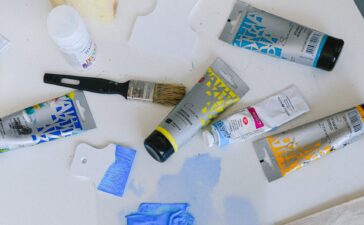The crafting world has experienced a storm of popularity from resin which now fascinates both professional artists and DIY enthusiasts. Your projects will achieve greater heights when you select appropriate resin colors for creating jewelry and tabletops and art pieces. Choosing the right resin color stands as a challenge when you have such a wide variety of choices in your hand. Selecting the right color goes beyond appearance because it demands both creative self-expression with awareness of your materials.
Aesthetic stories appear through different resin colors that range from bright jewel hues to delicate pastel hues. The following guide explains all essential aspects you need to consider before deciding on resin colours for your upcoming project. The following text introduces a universe that combines chemical processes with artistic innovation.
Understanding the Different Types of Resin Pigments
Resin pigments serve as essential tools to reach the correct color combination in project work. Different resin forms exist which present distinctive qualities for artists.
Enhance your creations with vibrant resin colour options, perfect for adding depth and character to any project while ensuring a long-lasting, glossy finish.
First, there are liquid dyes. Powdered pigments serve multiple purposes because their combined properties allow effortless mixing with resin for bold appearance. These ingredients work well for transparency purposes and depth enhancement.
Then, we have powdered pigments. Mica pigments form opaque coatings that create dynamic color effects upon combination with different pigments. The textural quality of these materials introduces new features to your project designs.
Another option is mica powders. Mica powders bring shimmer that upgrades projects to an elegant state while maintaining visual sophistication. Because of their reflective properties powdered pigments become excellent tools for adding glimmer to a mixed color palette without darkening the base hue.
The composition of epoxy pigments leads to their special formulation dedicated for resin applications resulting in radiant colors. The colors in these pigments stay bold while resisting fading so they work perfectly for extended-lasting artwork applications.
Factors to Consider When Choosing a Resin Color
Selecting appropriate resin colorations for your project will directly affect its end visual appeal. Your first step should begin by determining the function of your piece. The resin should fulfill either practical needs or serve as decoration or act as both functionality and decoration. When making selection decisions refer to environmental factors.
The proper illumination stands essential in finishing your project successfully. The appearance of colours under natural light differs from location to location which means you should test the samples across multiple environments before making a final choice.
The resin choice requires examination in relation to what objects you will combine with it. Various colors affect wood and metal and fabric at different rates. A combination of well-blended colors increases aesthetic charm in the visual presentation.
Current trend analysis together with personal design choices remains essential for project assessment. The traditional color palette can be appealing yet bold choices in color selection create memorable visual statements for viewers to experience.
Modify different pigments until you achieve the exact hue you have envisioned. Scientific testing generates distinctive outcomes which diverge from standard architectural expressions.
Popular Resin Color Combinations and Their Effects
The combination of colors in resin artwork allows you to reach exceptional creative results. Your project obtains visual power through the combination of vivid colors alongside neutral tones that form a powerful visual contrast. The merging of vibrant teal with soft beige produces projects that gain both depth and warmth qualities.
Using pastel colors in unison creates an atmosphere which brings peace to observers. The combination of lavender together with mint green creates calmness which works exceptionally well for home decoration pieces.
The energetic effect that pops into a space stems from using deep red together with golden yellow. The pairing works perfectly for creating dramatic statement pieces that serve art installation needs.
Running metallic elements into your design style does not represent a problem. Fabrics with gold or silver accents together with dark tones bring both sophisticated elegance and ornate charm that makes your project noticeable in any environment. Providing the perfect mixture results in ordinary becoming extraordinary with minimal work involved.
Tips for Achieving Your Desired Color with Resin
The process of obtaining desired resin colors presents enjoyable challenges for most users. Start by using high-quality pigments. The correct pigment selection makes possible results that remain both bright and accurate in color representation.
Introduce pigment to the resin solution one portion at a time. The addition of more material remains easier than trying to correct excessive darkness in your mixture. Keep track of your pigment-to-resin ratios since they will benefit future projects.
Experiment with layering different colours. You can produce depth and special visual effects when you use this mixing method to achieve customized pieces.
Perform tests of your mixtures with surplus materials before using them on final pieces. You can observe color blending before cure time which provides understanding about final appearance.
Don’t hesitate to combine pigments! Using mixed shades produces custom-looking variations that make each pour individually creative.
Creative Ways to Incorporate Resin Colors in Your Projects
Resin provides infinite creative opportunities throughout which colour plays a key role. An innovative approach for including resin color into your current project follows these guidelines.
The concept of art piece development should combine multiple color shades. The visual appeal grows when you pour opposing resin color layers into a mold design. When applied correctly this technique yields aesthetically pleasing geode appearance as well as abstract forms which grab viewer interest.
A different method involves the use of colored resin for creating functional objects. Application of colorful resin in making coasters and trays with matching furniture accents allows you to create useful items that add visual appeal to your home interior. Select colors which will either match or create dramatic differences with current furniture pieces.
Aside from functional items and coasters and trays resin coloring proves highly beneficial when producing jewelry pieces. Using the appropriate pigments will transform basic designs into showstopping pieces regardless of which color palette you select from bold to pastel shades.
Make sure your project includes both textures in combination with the color palette. Including glitter and metallic powders and natural components including flowers and leaves will deepen your projects through dimension-making while improving their aesthetic appeal.
Designing seasonal art with appropriate color schemes becomes possible by adopting winter-themed soft blues and whites or summer-oriented vibrant greens and yellows.
Creativity with resin colors enables you to create distinctive artistic pieces which represent your individual style and artistic outlook.






